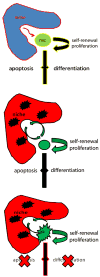Primary brain tumors, neural stem cell, and brain tumor cancer cells: where is the link?
- PMID: 20045420
- PMCID: PMC2839061
- DOI: 10.1016/j.neuropharm.2009.12.019
Primary brain tumors, neural stem cell, and brain tumor cancer cells: where is the link?
Abstract
The discovery of brain tumor-derived cells (BTSC) with the properties of stem cells has led to the formulation of the hypothesis that neural stem cells could be the cell of origin of primary brain tumors (PBT). In this review we present the most common molecular changes in PBT, define the criteria of identification of BTSC and discuss the similarities between the characteristics of these cells and those of the endogenous population of neural stem cells (NPCs) residing in germinal areas of the adult brain. Finally, we propose possible mechanisms of cancer initiation and progression and suggest a model of tumor initiation that includes intrinsic changes of resident NSC and potential changes in the microenvironment defining the niche where the NSC reside.
Copyright 2009 Elsevier Ltd. All rights reserved.
Figures



Similar articles
-
Neural stem cells, tumour stem cells and brain tumours: dangerous relationships?Biochim Biophys Acta. 2007 Dec;1776(2):125-37. doi: 10.1016/j.bbcan.2007.07.006. Epub 2007 Aug 16. Biochim Biophys Acta. 2007. PMID: 17868999 Review.
-
Gliomagenesis and the use of neural stem cells in brain tumor treatment.Anticancer Agents Med Chem. 2010 Feb;10(2):121-30. doi: 10.2174/187152010790909290. Anticancer Agents Med Chem. 2010. PMID: 20184546 Free PMC article. Review.
-
The SVZ and Its Relationship to Stem Cell Based Neuro-oncogenesis.Adv Exp Med Biol. 2015;853:23-32. doi: 10.1007/978-3-319-16537-0_2. Adv Exp Med Biol. 2015. PMID: 25895705 Review.
-
Developmental signaling pathways in brain tumor-derived stem-like cells.Dev Dyn. 2007 Dec;236(12):3297-308. doi: 10.1002/dvdy.21381. Dev Dyn. 2007. PMID: 18000980 Review.
-
[A hypothesis: neural glial cells, neural stem cells and tumor stem cells transform each other depending on the micro-ecological environment].Zhonghua Zhong Liu Za Zhi. 2010 Jan;32(1):76-8. Zhonghua Zhong Liu Za Zhi. 2010. PMID: 20211077 Chinese. No abstract available.
Cited by
-
Low-Density Lipoprotein Pathway Is a Ubiquitous Metabolic Vulnerability in High Grade Glioma Amenable for Nanotherapeutic Delivery.Pharmaceutics. 2023 Feb 10;15(2):599. doi: 10.3390/pharmaceutics15020599. Pharmaceutics. 2023. PMID: 36839921 Free PMC article.
-
Imaging glioma initiation in vivo through a polished and reinforced thin-skull cranial window.J Vis Exp. 2012 Nov 20;(69):4201. doi: 10.3791/4201. J Vis Exp. 2012. PMID: 23207870 Free PMC article.
-
Stem cells as therapeutic vehicles for the treatment of high-grade gliomas.Neuro Oncol. 2012 Mar;14(3):256-65. doi: 10.1093/neuonc/nor204. Epub 2011 Dec 13. Neuro Oncol. 2012. PMID: 22166262 Free PMC article. Review.
-
Cell cycle regulation during neurogenesis in the embryonic and adult brain.Stem Cell Rev Rep. 2013 Dec;9(6):794-805. doi: 10.1007/s12015-013-9460-5. Stem Cell Rev Rep. 2013. PMID: 23900682 Review.
-
Neural stem/progenitor cells display a low requirement for oxidative metabolism independent of hypoxia inducible factor-1alpha expression.J Neurochem. 2013 May;125(3):420-9. doi: 10.1111/jnc.12204. Epub 2013 Mar 11. J Neurochem. 2013. PMID: 23410250 Free PMC article.
References
-
- Ahn S, Joyner AL. In vivo analysis of quiescent adult NSCs responding to Sonic hedgehog. Nature. 2005;437(7060):894–7. - PubMed
-
- Altman J, Das GD. Autoradiographic Examination of the Effects of Enriched Environment on the Rate of Glial Multiplication in the Adult Rat Brain. Nature. 1964;204:1161 – 1163. - PubMed
-
- Alonso MM, Fueyo J, Shay JW, Aldape KD, Jiang H, Lee OH, Johnson DG, Xu J, Kondo Y, Kanzawa T, Kyo S, Bekele BN, Zhou X, Nigro J, McDonald JM, Yung WK, Gomez-Manzano C. Expression of transcription factor E2F1 and telomerase in glioblastomas: mechanistic linkage and prognostic significance. J Natl Cancer Inst. 2005;97(21):1589–600. - PubMed
Publication types
MeSH terms
Substances
Grants and funding
LinkOut - more resources
Full Text Sources
Other Literature Sources
Medical

